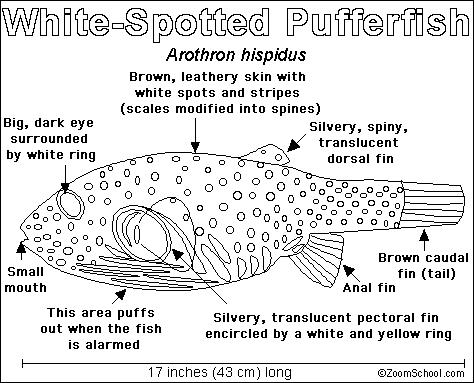
 |
| You might also like: | Eel Printouts | Swordfish Printout | Bluefin Tuna Printout | Copepod Printout | ANGELSHARK | Today's featured page: Mustelids: The Weasel Family |
| EnchantedLearning.com More Fish Printouts | Animal Printouts Label Me! Printouts |


The Pufferfish is also known as the blowfish, fugu, swellfish, and globefish. It is called the pufferfish because when it is threatened, it puffs up to about twice its normal size by gulping water. In this engorged state, the pufferfish can swim at only about half its normal speed.
There are about 100 species of pufferfish. Most pufferfish are found in sub-tropical and tropical marine waters (including coral reefs) in the Atlantic, Pacific, and Indian Oceans. Some puffers live in brackish and fresh water.
Poison: Many parts of the blowfish (including the liver, muscles, skin, and ovaries) contain an extremely strong, paralyzing poison called tetrodoxin. This poison is about a thousand times deadlier than cyanide. There is no known antidote for this poison. Fugu (torafugu or fugu rubripes, Japanese pufferfish) is eaten in Japan, but is only cooked by specially-trained chefs who can minimize the amount of poison. Even so, many Japanese diners have died from eating this poisonous delicacy.
Diet: Pufferfish are carnivores (meat-eaters). They eat corals, sponges, sea urchins, other echinoderms, and small crustaceans. Pufferfish crush and grind up their prey with their heavy, fused teeth.
Anatomy: Pufferfish have a small mouth, a tube-shaped body (when not engorged) and relatively small fins. When puffed up, they are almost spherical. Pufferfish range in size from just a few inches long to almost 2 feet long. A few species of pufferfish have spines on their body (modified scales), but many do not. The skin of puffers is very elastic (it can stretch very well).
| Search the Enchanted Learning website for: |